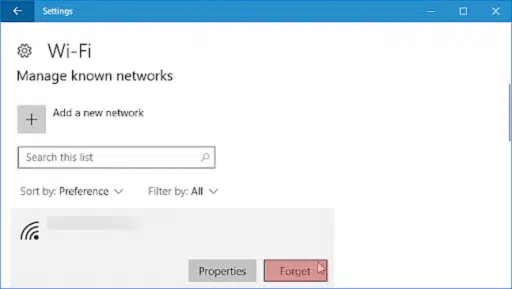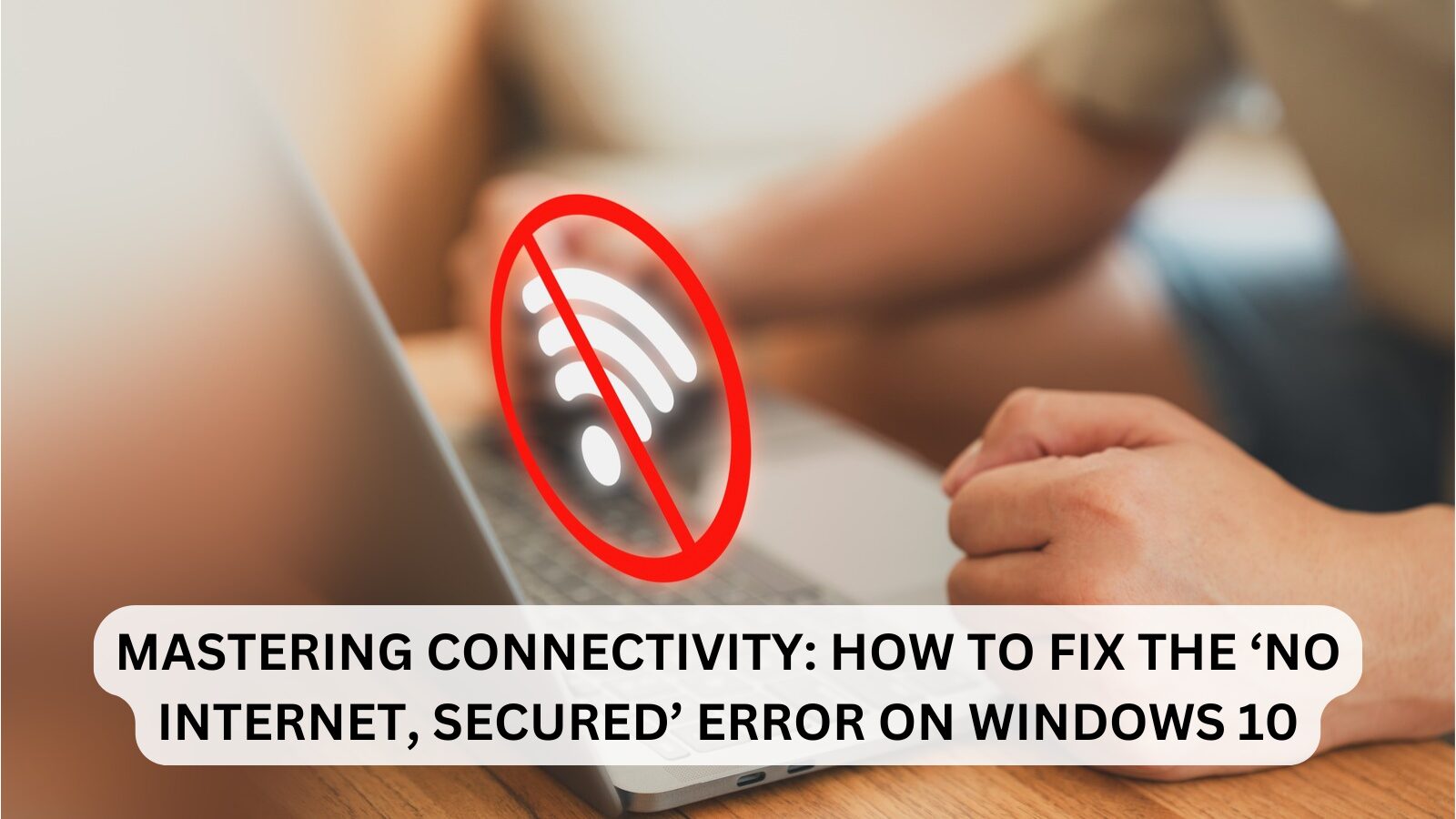Are you one of the many Windows 10 users facing the frustrating ‘No Internet, Secured’ error when trying to connect to Wi-Fi? This issue can be incredibly annoying, especially when you need a reliable internet connection for work, school, or entertainment. In this guide, we’ll not only show you how to fix the ‘No Internet, Secured’ error but also explain the common causes behind it and provide practical solutions to get you back online quickly.
Understanding the “No Internet, Secured” Error
What does it mean when you see ‘No Internet, Secured’ next to your Wi-Fi network? This error message typically appears when your device successfully connects to a Wi-Fi network but fails to access the internet. To better understand this issue, let’s explore some common scenarios where it occurs:
- After Windows Updates:
- The ‘No Internet, Secured’ error often appears after a Windows 10 update. While updates are essential for security and performance, they can sometimes cause compatibility issues with network drivers or configurations.
- Driver Problems:
- Outdated or incompatible network drivers are a common cause. Keeping your drivers up-to-date is crucial for maintaining a stable connection.
- Configuration Issues:
- Misconfigured network adapter settings, such as DNS settings or IP addresses, can lead to connectivity problems.
- IPv6 Settings:
- Enabling IPv6, a newer network protocol, can sometimes disrupt connections on certain networks. Disabling it may resolve the issue.
Now that we’ve identified the potential causes, let’s dive into the solutions to fix the ‘No Internet, Secured’ error and get you back online.
Solving the “No Internet, Secured” Error
Here are some methods to resolve the “No Internet, Secured” error:
Method 1: Reset Your Connection
Sometimes, a simple network reset is all you need to fix the ‘No Internet, Secured’ error. Here’s how to do it:
- For Wi-Fi Connections:
- Click on the internet icon in your taskbar and select the network showing ‘No Internet, Secured.’
- If available, click “Forget.” If not, go to Network & Internet settings to find this option.

- For Ethernet Connections:
- Unplug the Ethernet cable and enable Airplane mode (if available).
- Restart your device.
- After restarting, turn off Airplane mode, plug the Ethernet cable back in, and reconnect to your network.
Once done, check if the ‘No Internet, Secured’ error has been resolved. This quick reset can often restore your connection without further troubleshooting.
Method 2: Automatically Obtain DNS Details
Configuring DNS server settings can be a crucial step in troubleshooting network issues like the ‘No Internet, Secured’ error. Here’s how to adjust your DNS settings:
- Open Network Connections:
- Press Ctrl + X to open the context menu, then select Network Connections.
- Select Your Connection Type:
- Choose your current connection type (e.g., Wi-Fi or Ethernet) and click “Change adapter options.”

- Access Connection Properties:
- Right-click on your current connection and select “Properties.”
- Configure IP and DNS Settings:
- Ensure that “Obtain an IP address automatically” and “Obtain DNS server address automatically” are selected.

- Restart Your Computer:
- Restart your device to apply the changes and check if the issue is resolved.
By configuring your DNS settings, you can often resolve network connectivity issues and restore a stable internet connection.
Method 3: Set a New DNS Server
If the automatic DNS configuration isn’t working, manually entering a DNS server can help. Consider using popular DNS servers like 1.1.1.1 or Google’s DNS servers (8.8.8.8 and 8.8.4.4).
Method 4: Disable Internet Protocol Version 6 (IPv6)
Windows 10 often enables IPv6 by default, which can sometimes cause connectivity issues like the ‘No Internet, Secured’ error. If you suspect IPv6 is the problem, you can disable it by following these steps.
Method 5: Reinstall Your Network Adapter
Reinstalling your network adapter can be an effective solution if the ‘No Internet, Secured’ error is caused by driver issues. Here’s how to do it:
- Open Device Manager:
- Press Windows + X and select Device Manager.
- Expand Network Adapters:
- In the Device Manager window, expand the “Network adapters” section.
- Uninstall the Network Adapter:
- Right-click your network adapter and select “Uninstall device.”

- Confirm the uninstallation when prompted.
- Reinstall the Network Adapter:
- Go to the top menu, click Action, and select “Scan for hardware changes.” This will reinstall the network adapter automatically.

These steps can often resolve the ‘No Internet, Secured’ error. However, if the issue persists, there are additional troubleshooting methods you can try.
Method 6: Refresh Your IP Configuration
Outdated or incorrect IP and DNS settings can often lead to network issues like the ‘No Internet, Secured’ error. Here’s how to fix them:
Step 1: Open Command Prompt as Administrator
- Press Windows + X and select Command Prompt (Admin) or Windows Terminal (Admin).
Step 2: Run Commands to Refresh IP Configuration
- Enter the following commands one by one, pressing Enter after each:
ipconfig /release
ipconfig /renew
ipconfig /flushdns
These commands will release and renew your IP address and clear the DNS cache, potentially resolving the issue.
Method 7: Perform a Winsock Reset
Resetting the Windows Sockets API (Winsock) can help resolve connectivity issues like the ‘No Internet, Secured’ error. Here’s how to do it:
- Step 1: Open Command Prompt as Administrator
Press Windows + X and select Command Prompt (Admin) or Windows Terminal (Admin).
- Step 2: Run the Winsock Reset Commands
Enter the following commands one by one, pressing Enter after each:
netsh winsock reset
netsh int ip resetThese commands will reset the Winsock catalog and TCP/IP stack, potentially fixing the issue.
- Step 3: Restart Your Computer
After running the commands, restart your computer to apply the changes.
Method 8: Run the Internet Connections Troubleshooter
Windows 10 offers built-in troubleshooters that can help identify and fix network-related problems. Running the Internet Connections troubleshooter can be quite effective.

Method 9: Update Windows 10 and Your Drivers
Keeping your Windows 10 operating system and drivers up-to-date is crucial for maintaining a stable internet connection. Sometimes, simply updating to the latest version of Windows 10 can resolve the ‘No Internet, Secured’ error.
By following the comprehensive steps outlined in this guide, you should be well-equipped to tackle the ‘No Internet, Secured’ error on your Windows 10 device. Whether you’re dealing with driver issues, configuration problems, or IPv6-related troubles, these methods can help you get back online quickly.
Remember, maintaining a reliable internet connection is essential in today’s digital age. With these troubleshooting techniques, you can stay connected and productive. Enjoy your uninterrupted online experience!
One more thing
If you’re in search of a software company that embodies integrity and upholds honest business practices, your quest ends here at Ecomkeys.com. As a Microsoft Certified Partner, we prioritize the trust and satisfaction of our customers. Our commitment to delivering reliable software products is unwavering, and our dedication to your experience extends far beyond the point of sale. At Ecomkeys.com, we provide a comprehensive 360-degree support system that accompanies you throughout your software journey. Your trust is our foundation, and we’re here to ensure that every interaction with us is a positive and trustworthy one.

